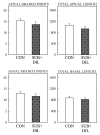Chronic psychosocial stress causes apical dendritic atrophy of hippocampal CA3 pyramidal neurons in subordinate tree shrews
- PMID: 8627386
- PMCID: PMC6579123
- DOI: 10.1523/JNEUROSCI.16-10-03534.1996
Chronic psychosocial stress causes apical dendritic atrophy of hippocampal CA3 pyramidal neurons in subordinate tree shrews
Abstract
We have shown previously that repeated laboratory restraint stress or daily corticosterone administration affects the structure of CA3 hippocampal neurons in rats. In the present study, we investigated the effect of repeated daily psychosocial stress on the structure of hippocampal CA3 pyramidal neurons in male tree shrews (Tupaia belangeri). Male tree shrews develop social hierarchies in which subordinates show characteristic changes in physiological and behavioral parameters when confronted with a dominant. In the present experiments, subordinate animals lost body weight soon after starting the daily social conflict, and urinary excretion of cortisol was elevated throughout the experiment as compared with the control period. Golgi-impregnated brain tissue from subordinates exposed to 28 d (1 hr/d) of social confrontations was compared with that from control nonstressed animals. The apical dendrites of the CA3 pyramidal cells from subordinates had a decreased number of branch points and total dendritic length as compared with controls. No differences were observed in apical dendritic spine density or in the basal dendritic tree morphology. The stress-induced CA3 apical dendritic atrophy in subordinates was prevented by administering daily oral doses of the antiepileptic drug phenytoin (Dilantin, Sigma, St. Louis, MO) (200 mg/kg), which interferes with excitatory amino acid (EAA) action. These results suggest that the naturalistic stressor psychosocial stress induces specific structural changes in hippocampal neurons of subordinate male tree shrews. These changes, like those in the rat after glucocorticoid treatment or restraint stress, probably are mediated by activation of the hypothalamo-pituitary-adrenal-axis acting in concert with endogenous EAAs from mossy fiber input.
Figures





References
-
- Aue D (1989) Konfrontationen zwischen männlichen Spitzhörnchen (Tupaia belangeri): konsequenzen der Sozialkontakte für Verhalten und Physiologie sowie der Einfluss individueller und äusserer Faktoren auf die Dominanzentscheidung. Göttingen: Thesis.
-
- Bayer SA. Hippocampal region. In: Paxinos G, editor. The rat nervous system. Academic; New York: 1985. pp. 335–352.
-
- Blanchard DC, Sakai RR, McEwen BS, Weiss SM, Blanchard RJ. Subordination stress: behavioral, brain and neuroendocrine correlations. Behav Brain Res. 1993;58:113–121. - PubMed
-
- Clairbone BJ, Amaral DG, Cowan WH. A light microscopic analysis of the mossy fibres of the rat dentate gyrus. J Comp Neurol. 1986;246:435–458. - PubMed
-
- Convit A, de Leon MJ, Tarshish CY, de Santi S, Kluger A, Rusinek H, George AE. Hippocampal volume losses in minimally impaired elderly. Lancet. 1995;345:266. - PubMed
Publication types
MeSH terms
Substances
Grants and funding
LinkOut - more resources
Full Text Sources
Other Literature Sources
Medical
Miscellaneous
